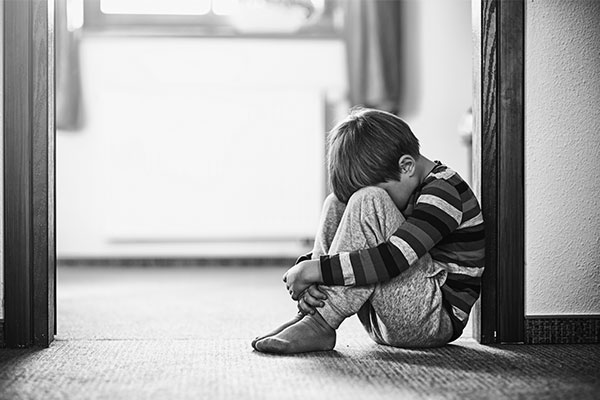Helping Children Cope with Violent Trauma

The intense, confusing, and frightening emotions that follow a traumatic event or natural disaster can be even more pronounced in children—whether they directly experienced the traumatic event or were repeatedly exposed to horrific media images after the fact. While children and adolescents are more vulnerable to being traumatized than adults, with the right support and reassurance, they are also able to recover faster. Using these coping tips, you can help your child regain an emotional balance, restore their trust in the world, and move on from the trauma.
What Are the Effects of Trauma on Children?
Unexpectedly losing a loved one or being involved in a natural disaster, motor vehicle accident, plane crash, or violent attack can be overwhelmingly stressful for children. A traumatic event can undermine their sense of security, leaving them feeling helpless and vulnerable, especially if the event stemmed from an act of violence, such as a physical assault, mass shooting, or terrorist attack. Even kids or teens not directly affected by a disaster can become traumatized when repeatedly exposed to horrific images of the event on the news or social media.
Children age 5 and under might:
- Show signs of fear
- Cling to parent or caregiver
- Cry, scream, or whimper
- Move aimlessly or become immobile
- Return to behaviors common at a younger age, such as thumb sucking or bedwetting
Children age 6 to 11 might:
- Lose interest in friends, family, and fun activities
- Have nightmares or other sleep problems
- Become irritable, disruptive, or angry
- Struggle with school and homework
- Complain of physical problems
- Develop unfounded fears
- Feel depressed, emotionally numb, or guilty over what happened
Adolescents age 12 to 17 might:
- Have flashbacks to the event, nightmares, or other sleep problems
- Avoid reminders of the event
- Abuse drugs, alcohol, or tobacco
- Act disruptive, disrespectful, or destructive
- Have physical complaints
- Feel isolated, guilty, or depressed
- Lose interest in hobbies and interests
- Have suicidal thoughts
Source: National Institute of Mental Health
Whatever the age of your child, it’s important to offer extra reassurance and support following a traumatic event. A child’s reaction to a disaster or trauma can be greatly influenced by their parents’ response, so it’s important to educate yourself about trauma and traumatic stress. The more you know about the symptoms, effects, and treatment options, the better equipped you’ll be to help your child recover. With your love and support, the unsettling thoughts and feelings of traumatic stress can start to fade and your child’s life can return to normal in the days or weeks following the event.
Kids and trauma recovery tip 1: Minimize media exposure
Children who’ve experienced a traumatic event can often find relentless media coverage to be further traumatizing. Excessive exposure to images of a disturbing event—such as repeatedly viewing video clips on social media or news sites—can even create traumatic stress in children or teens who were not directly affected by the event.
Limit your child’s media exposure to the traumatic event. Don’t let your child watch the news or check social media just before bed, and make use of parental controls on the TV, computer, and tablet to prevent your child from repeatedly viewing disturbing footage.
As much as you can, watch news reports of the traumatic event with your child. You can reassure your child as you’re watching and help place information in context.
Avoid exposing your child to graphic images and videos. It’s often less traumatizing for a child or teen to read the newspaper rather than watch television coverage or view video clips of the event.
Tip 2: Engage your child
You can’t force your child to recover from traumatic stress, but you can play a major role in the healing process by simply spending time together and talking face to face, free from TV, games, and other distractions. Do your best to create an environment where your kids feel safe to communicate what they’re feeling and to ask questions.
Provide your child with ongoing opportunities to talk about what they went through or what they’re seeing in the media. Encourage them to ask questions and express their concerns but don’t force them to talk.
Acknowledge and validate your child’s concerns. The traumatic event may bring up unrelated fears and issues in your child. Comfort for your child comes from feeling understood and accepted by you, so acknowledge their fears even if they don’t seem relevant to you.
Reassure your child. The event was not their fault, you love them, and it’s OK for them to feel upset, angry, or scared.
Don’t pressure your child into talking. It can be very difficult for some kids to talk about a traumatic experience. A young child may find it easier to draw a picture illustrating their feelings rather than talk about them. You can then talk with your child about what they’ve drawn.
Be honest. While you should tailor the information you share according to your child’s age, honesty is important. Don’t say nothing’s wrong if something is wrong.
Do “normal” activities with your child that have nothing to do with the traumatic event. Encourage your child to seek out friends and pursue games, sports, and hobbies that they enjoyed before the incident. Go on family outings to the park or beach, enjoy a games night, or watch a funny or uplifting movie together.
Tip 3: Encourage physical activity
Physical activity can burn off adrenaline, release mood-enhancing endorphins, and help your child sleep better at night.
Find a sport that your child enjoys. Activities such as basketball, soccer, running, martial arts, or swimming that require moving both the arms and legs can help rouse your child’s nervous system from that “stuck” feeling that often follows a traumatic experience.
Offer to participate in sports, games, or physical activities with your child. If they seem resistant to get off the couch, play some of their favorite music and dance together. Once a child gets moving, they’ll start to feel more energetic.
Encourage your child to go outside to play with friends or a pet and blow off steam.
Schedule a family outing to a hiking trail, swimming pool, or park.
Take younger children to a playground, activity center, or arrange play dates.
Tip 4: Feed your child a healthy diet
The food your child eats can have a profound impact on their mood and ability to cope with traumatic stress. Processed and convenience food, refined carbohydrates, and sugary drinks and snacks can create mood swings and worsen symptoms of traumatic stress. Conversely, eating plenty of fresh fruit and vegetables, high-quality protein, and healthy fats, especially omega-3 fatty acids, can help your child better cope with the ups and downs that follow a disturbing experience.
Focus on overall diet rather than specific foods. Kids should be eating whole, minimally processed food—food that is as close to its natural form as possible.
Limit fried food, sweet desserts, sugary snacks and cereals, and refined flour. These can all exacerbate symptoms of traumatic stress in kids.
Be a role model. The childhood impulse to imitate is strong so don’t ask your child to eat vegetables while you gorge on soda and French fries.
Cook more meals at home. Restaurant and takeout meals have more added sugar and unhealthy fat so cooking at home can have a huge impact on your kids’ health. If you make large batches, cooking just a few times can be enough to feed your family for the whole week.
Make mealtimes about more than just food. Gathering the family around a table for a meal is an ideal opportunity to talk and listen to your child without the distraction of TV, phones, or computers.
Tip 5: Rebuild trust and safety
Trauma can alter the way a child sees the world, making it suddenly seem a much more dangerous and frightening place. Your child may find it more difficult to trust both their environment and other people. You can help by rebuilding your child’s sense of safety and security.
Create routines. Establishing a predictable structure and schedule to your child’s or teen’s life can help to make the world seem more stable again. Try to maintain regular times for meals, homework, and family activities.
Minimize stress at home. Try to make sure your child has space and time for rest, play, and fun.
Manage your own stress. The more calm, relaxed, and focused you are, the better you’ll be able to help your child.
Speak of the future and make plans. This can help counteract the common feeling among traumatized children that the future is scary, bleak, and unpredictable.
Keep your promises. You can help to rebuild your child’s trust by being trustworthy. Be consistent and follow through on what you say you’re going to do.
If you don’t know the answer to a question, don’t be afraid to admit it. Don’t jeopardize your child’s trust in you by making something up.
Remember that children often personalize situations. They may worry about their own safety even if the traumatic event occurred far away. Reassure your child and help place the situation in context.
When to seek treatment for your child’s trauma
Usually, your child’s feelings of anxiety, numbness, confusion, guilt, and despair following a traumatic event will start to fade within a relatively short time. However, if the traumatic stress reaction is so intense and persistent that it’s interfering with your child’s ability to function at school or home, they may need help from a mental health professional—preferably a trauma specialist.
Warning signs include:
- Six weeks have passed, and your child is not feeling any better
- Your child is having trouble functioning at school
- Your child is experiencing terrifying memories, nightmares, or flashbacks
- The symptoms of traumatic stress manifest as physical complaints such as headaches, stomach pains, or sleep disturbances
- Your child is having an increasingly difficult time relating to friends and family
- Your child or teen is experiencing suicidal thoughts
- Your child is avoiding more and more things that remind them of the traumatic event
This content adapted from an article by Melinda Smith, M.A., Lawrence Robinson, and Jeanne Segal, Ph.D., and can be viewed here at HelpGuide.org.






















